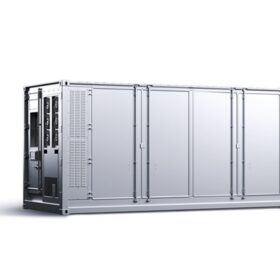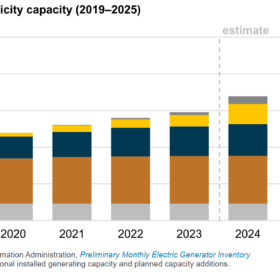JD.com, one of the China’s biggest online retailers will install what it is describing as the world’s largest solar rooftop across its dozens of logistics buildings and warehouses. Total generation capacity is expected to be 200 MW with the panels coming online next year to generate more than 160 GWh per year. JD.com said the company will work with partners including wind turbine manufacturer Goldwind and Longi to develop the project. Source: Chinese PV Industry Brief at pv magazine global.
How a plan to save the power system disappeared: In August of 2018, Joshua Novacheck, a 30-year-old research engineer for the U.S. National Renewable Energy Laboratory, was presenting the most important study of his nascent career. He couldn’t have known it yet, but things were about to go very wrong. At a gathering of experts and policy makers in Lawrence, Kansas, Novacheck was sharing the results of the Interconnections Seam Study, better known as Seams. The Seams study demonstrated that stronger connections between the U.S. power system’s massive eastern and western power grids would accelerate the growth of wind and solar energy—hugely reducing American reliance on coal, the fuel contributing the most to climate change, and saving consumers billions. According to interviews with five current and former DOE and NREL sources, supported by more than 900 pages of documents and emails obtained by InvestigateWest through FOIA requests and by additional documentation from industry sources, Trump officials would ultimately block Seams from seeing the light of day. And in doing so, they would set back America’s efforts to slow climate change. This article is a collaboration between The Atlantic and InvestigateWest.
/media/img/posts/2020/08/X9s68WMY3hhA7y79dR2nfcKdYIOkH2S2wZSv6J9ldYMAmz2CCnDHHaKJpyWHdj0BaN7OuQtG3APWtc5ECn2adH8fFnlBSRvvG_WZKr0pUfjwxUPF0W637jV7oU2svKGYzwpAzyx4dl6qKhlZ4Q-1/original.png)
In May, the Trump administration seized a 250-ton, $3 million Chinese high-voltage transformer that was on its way to Colorado. It was taken to Sandia National Labs in New Mexico for reasons unknown. What happened to it still remains a mystery. On May 1, the Trump Administration issued a surprise Executive Order (EO), “Securing the United States Bulk Power System.” The directive aims to keep critical equipment supplied by foreign adversaries out of the nation’s power grid due to supposed supply chain security threats. Shortly after the EO’s release came the surprising revelation that a federally owned utility managed by DOE, the Western Area Power Administration (WAPA), hijacked a nearly $3 million Chinese-manufactured transformer initially intended for one of its substations in Colorado. WAPA instead diverted it to one of DOE’s national laboratories, Sandia National Labs, in New Mexico. Source: Vice
Midwest energy companies pledge to build nation’s largest interstate electric vehicle charging network: EV owners will soon be taking road trips across the Midwest with increased confidence. That’s because six regional energy companies have committed to a first-of-its-kind Memorandum of Cooperation, committing to work together to build a vast network of Midwest EV charging stations by the end of 2022. Six energy companies have pledged to support this project, including Ameren Illinois, Ameren Missouri, Consumers Energy, DTE Energy, Evergy and Oklahoma Gas and Electric. Source: Newswire
This content is protected by copyright and may not be reused. If you want to cooperate with us and would like to reuse some of our content, please contact: editors@pv-magazine.com.







What’s the purpose of posting a picture of Trump being acquitted in todays article? Is this a political statement from PV Magazine supporting Trump?
Thanks,
Vote!
I think the picture of Trump, along with the Seams and Transformer stories are meant to accuse Trump of something. PV Magazine is no friend of Trump. The Seams paper is not just a blueprint on how to improve the grid, it is a blueprint to destroy it. It should be classified and hidden away from public view.
The missing transformer is another security issue. We don’t make them here and if they fail they can take a year to replace. The Seams study points out that only 9 substations using these transformers need to be taken out to destroy the U.S. grid for a year, in theory, but on a practical level the outage would likely be permanent, as 90% of the U.S. population would die.
Sandia is no doubt checking the transformer made by an enemy of the U.S. to see if it meets spec or if it contains a hidden failure mechanism or shoddy construction. Chinese makers can do very good work, but they always do as they are told by their government.
There is no conspiracy here, just good security. It should also be a warning to us that we should work to decentralize power. We aren’t just vulnerable to foreign actors. Hurricane Sally’s surprise visit to Florida took out my grid connection for 3 1/2 days, but my solar and 3000 lbs of batteries kept things pretty normal at our house. I would urge anyone with a grid-tie-only system to make changes to their hardware to allow some independence of the grid.
Can you please explain how people can use this to destroy the grid and it needs to be classified?
The transmission line data is publicly available along with the power plant data and information. All of it was made public for years and years.
Just wondering why an integration study should be hidden from public view.